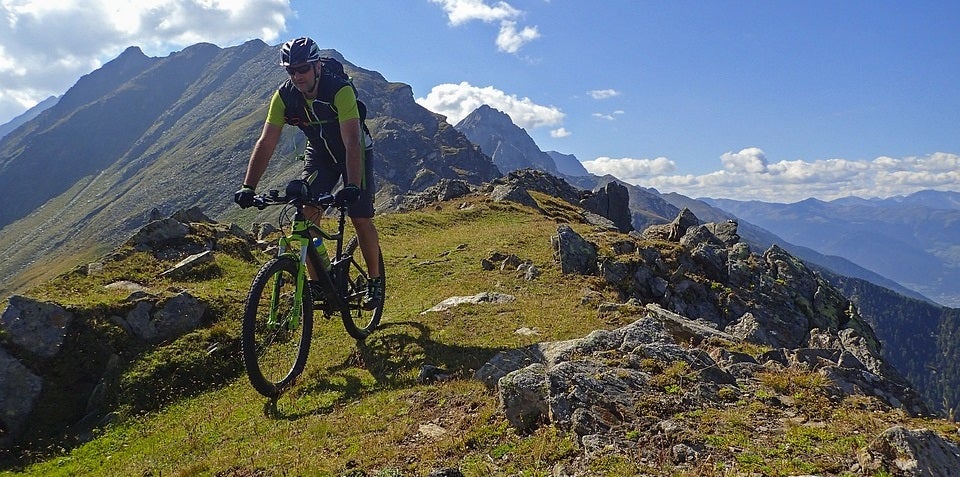
Our Editors independently research, test, and rate what we feel are the best products. We use affiliate links and may receive a small commission on purchases.
Mountain biking has come a long way since it was born in California in the 70’s. Back then fearless riders would hurtle down fire roads on junkyard bikes named “klunkerz” after the sound they made.
Soon after, the first mountain bikes were produced and looked a lot like road bikes with bigger tyres. Over the years, mountain bikes have evolved to look more like off road machines capable of riding at speed up and down rough terrain.
If you are a fan of nature and the wilderness and want to get into a multifaceted sport that has more places to practice it than you can ever ride, then mountain biking is guaranteed to make you happy!
Looking for a different type of bike? Read our comprehensive guide to every type of bicycle.
Getting Your First Mountain Bike
The Two Types of Mountain Bikes
Mountain bikes can be divided into two general types:
Hardtail
As the name suggests, hardtails do not have suspension at the back but will often have a suspension fork up front. No rear suspension means maximum power transfer.
Full Suspension
These bikes have a suspension fork and shock at the rear. There are various different frame designs. Full suspension bikes cost more due to the more complex frames and cost of the shock.
Wheel Size
There are three main sizes of wheels (diameter) used in mountain biking. Traditionally mountain bikes had 26” wheels and this was the norm for many years. One of the original klunkerz and pioneers of the sport Gary Fischer pushed the use of 29” wheels and these became popular with cross country racers.
The bigger wheel rolls easier over obstacles and moves the bike further per pedal stroke. The downside was more wheel flex and sloweer steering.
Then someone came up with 27.5” wheels as a compromise and this took off in a huge way. In the 2017 downhill world cup 29” wheels were used in this genre of the sport for the first time and they are also popular with some enduro racers.
After all the arguing about what is fastest, the industry and opinionated forum users are slowly realizing that it comes down to rider height and preference.
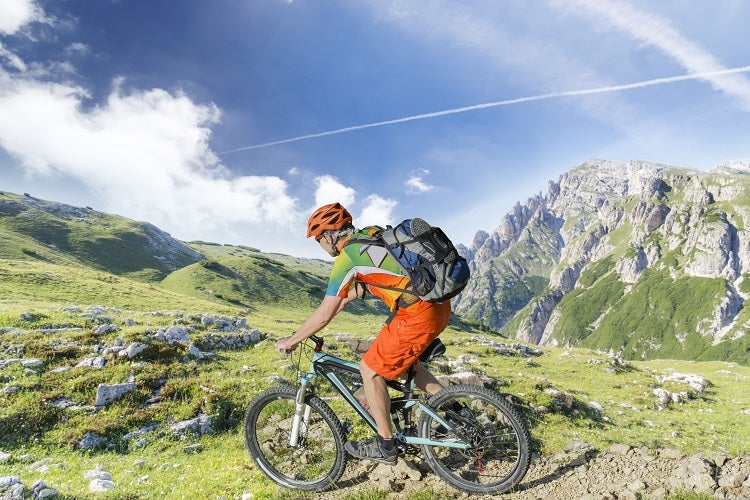
What Kind of Mountain Bike Do You Need?
The cheapest way to try out mountain biking is to rent a bike for a few rides and decide whether you really like it or not. Then once you have decided to invest, a hardtail is the cheapest option to get a capable mountain bike.
You may even be able to buy a used or ex rental bike but it is advisable to do so with someone who has experience of mountain bikes to avoid getting a bad deal or seriously damaged bike.
If you can afford it, then by all means go for a full suspension bike. There is no point in spending huge amounts on a medium or long travel bike (140mm or more rear suspension) at first as you will not have the skills to use the bike for what it is intended.
Longer travel means a heavier bike. To get started, look for something with 100mm or 120mm of suspension. As your skills progress you will at some point realize that you could do with a stronger bike with more travel.
Proper Clothing for Mountain Biking
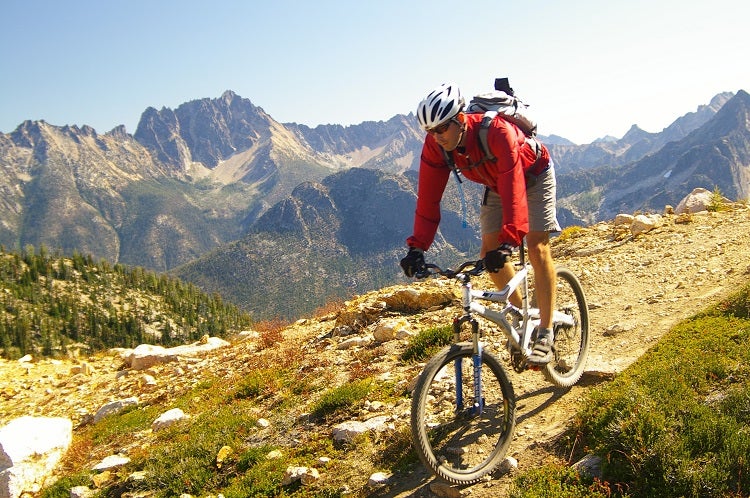
Mountain biking is not different from other sports in the fact that it has specialty clothing. Mountain bike specific clothing may seem expensive but it will absolutely increase your comfort on the bike.
Shirts, Shoes & Shorts
A good jersey will help keep you cool and wick away sweat and mountain bike shorts are cut just right for pedaling. It is highly advisable to invest in a good pair of padded MTB shorts. With the padding otherwise known as “chamois”, you will be able to ride for many hours in greater comfort in comparison to normal underwear.
Mountain bike shoes interact properly with the pedals and offer protection from objects at the side of the trail or in a crash. You do not have to spend a fortune on clothing as there are budget items on offer.
Helmet
Always wear a MTB helmet. There is no exception to this rule. If you are on your bike there is no reason not to have a helmet on. Some people remove it when riding uphill because they think they will not crash.
While the likelihood of crashing at slow speeds is indeed reduced, what happens if someone is riding fast down the same trail, comes round the corner and crashes into you? You need to wear a helmet at all times.
Eye Protection
After a helmet, the most important safety item is a pair of cycling sunglasses to keep wind and dust out of your eyes. Even in winter you should wear a clear pair of sunglasses because a surprising amount of small debris from the trail can end up hitting your face. If something lands in your eye then you will not be able to see properly.
Gloves
A pair of mountain bike specific gloves will give you better grip on the handlebars and protect your hands in a crash. After a helmet, gloves are the first safety item you should buy. As your riding progresses and you start riding rougher terrain, you might want to get a pair of kneepads.
Pads
Its inevitable that you are goin gto take some spills while riding no matter how skilled you are. Having some knee pads will save scraped knees and possible a smashed kneecap. They are not that expensive, get some!
Misc
Some rucksacks feature back protectors and there are other items of body armor available for really extreme riding. Taking a first aid kit and basic tool kit with you is a very good idea. Always tell someone where you are going and when you expect to be back.
If you will be riding back from the trails after dark then you will need some LED lights to be seen by other road users. Having a MTB backpack to carry all your gear is almost a necessity, especially if you plan on biking all day.
Look for one with a hydration bladder, a water bottle is not going to be enough.
Parts of a Mountain Bike
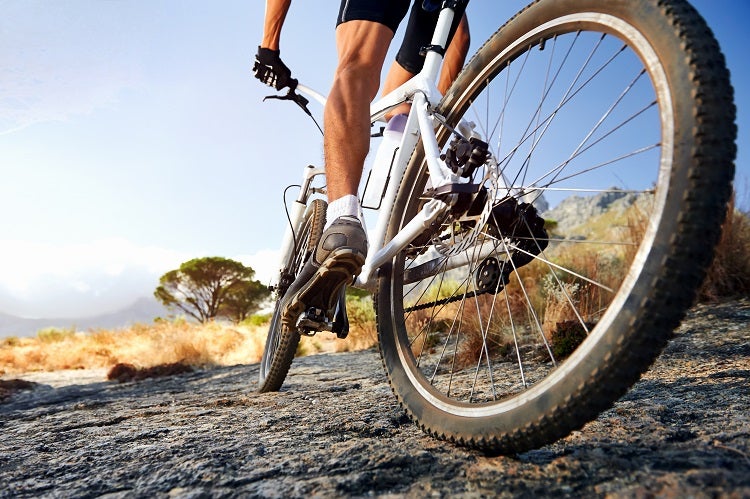
Frame
The frame of a mountain bike defines its character. Different materials and geometry create a different feel on the trail. All other parts are attached to the frame in some way.
Fork
The fork holds the front wheel. Most modern mountain bikes will have a suspension fork to soften the blow from impacts and provide better traction. How much travel a suspension fork has depends on the style of riding, with the travel increasing as the style of riding gets more extreme.
Shock
On a full suspension bike, the shock absorbs impacts that hit the rear wheel and provides better traction when cornering.
Wheels
Made up of a hub tied at tension to a rim with spokes, the wheels keep the bike moving.
Tires
Just like on a car, rubber tires give the bike traction and smooth out some of the trail “chatter”. There are a huge number of tires available with different widths, profiles and compounds. Here are our recommended MTB tires.
Drivetrain
This refers to everything that transfers the power from your legs to the wheels. Your feet sit on pedals, which are attached to cranks. A chainring (or chainrings) connected to the cranks pulls the chain forward, which rotates the cassette on the rear wheel, making it turn.
Having a good set of pedals will make riding more efficient. There are two types, Flat or Platform and Clipless. You can read more details on MTB pedals here.
The cassette is a nest of cogs for different gears. A derailleur moves the chain from one cog to the next. There may also be a derailleur at the front if there are multiple chainrings there.
Brakes
As you probably already guessed, the brakes slow the bike down. You may still find some mountain bikes with rim brakes, but most these days have disc brakes. A metal disc is screwed onto the hub and a caliper presses two brake pads onto the disc.
The most powerful brakes have hydraulic lines instead of cables. A bigger disc means more stopping power.
Handel Bars & Stem
The stem attaches to the steerer tube on the top of the fork and is held straight by the headset. The MTB handlebar attaches to the stem and is obviously there for your hands to steer the front wheel. Controls for the brakes and gears are mounted on the handlebars.
A long stem puts more weight on the front wheel, while a shorter stem gives faster steering. A wide bar slows down steering but gives more leverage, which is an advantage especially when riding at speed through rough terrain. Modern bike tend to have short stems with wide bars.
Saddle and Seatpost
What you sit on is called the saddle. Finding the right saddle is important to being comfortable on both short and long rides. The saddle clamps onto the seatpost, which is clamped into the frame. More advanced riders will use a dropper post. This allows to raise and lower the saddle with a lever on the handlebars. This is most often used for downhill riding.
Where Should You Start?
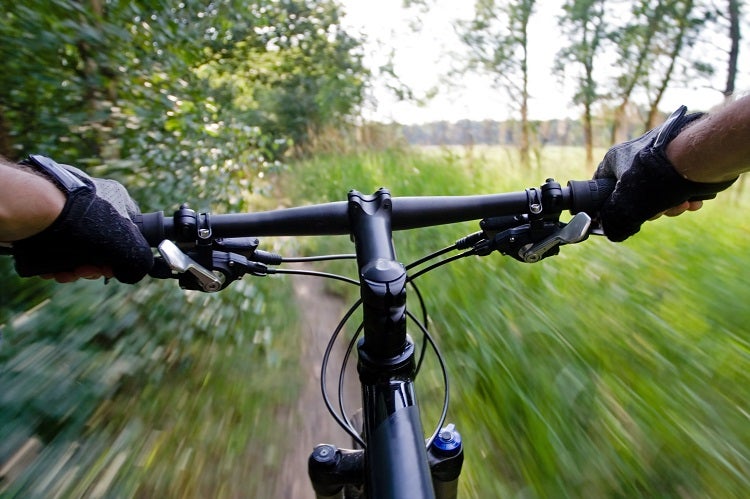
In terms of location, start riding your bike around your local woods or on easy trails at your nearest trail center or park. Get comfortable with using the gears and brakes, as well as how the bike feels before progressing onto the next level of trail.
You might want to think about taking an introductory course. Many trial centres offer these or find a mountain biking friend to walk you through the basics. To help you get going, here are a few tips to help you ride safely:
Plan – Always have a clear idea of where you want to ride and the weather conditions. Tell someone where you are going and when you expect to get back. Failing to do so can make any rescue operation much more difficult.
Look ahead – Keep your eyes up and looking as far down the trail as you can see. If you start at the immediate trail in front of your tire, you will not see upcoming obstacles. It is OK to glance down briefly but you should immediately look up again to choose a line down the trail and use your peripheral vision as much as possible for obstacles that you have already spotted.
Stand up – It is fine to be sitting down and pedalling when the trail is smooth. As soon as you need to ride over any obstacles like rocks or roots, you should stand up, keep your feet and pedals at the same height from the ground and lower your heels.
Heavy feet, light hands – Do not lean too much on the handlebars or you will not be able to steer properly. Keep a relaxed grip on the handlebars otherwise you will be stiff and using too much energy.
Stay calm and progress slowly – Breathe and relax. You will be surprised what a mountain bike can roll over so give new challenges a go. Do not take big steps as this could result in injury. Once you have achieved one thing, find something similar that is a tiny bit bigger.
In this way you can consistently build up your skills without putting yourself in danger. As a general rule, if you cannot see yourself doing something in your head, you should not try it.
Track it – There are many GPS bike computers available with a huge range of features. On a basic level you can see how far you have cycled and how fast. You can also use a computer to navigate a route and view maps of the surrounding terrain. You can also record your rides with activity tracking apps like Strava or upload your rides to them from your computer. You can then see how you have improved over time.
Another great reason to use Strava is for the huge number of “segments” worldwide. These are stretches of road or trail where you can see how fast you have ridden in comparison to other Strava users. You can view a table with all of your times and you get a notification each time you beat your personal best. This along with competing against others is a great motivation to get fitter and faster.
Night riding – Once you are confident, you may want to give night riding a go. This is a great way to keep riding through the darker winter months but it has it’s own set of risks.
If you want to give it a go, the first thing you will need is an appropriate headlight specifically intended for mountain biking at night. If you cannot properly see the trail, then you won’t get far!
The absolute minimum is one light on your helmet to ensure there is light where you are looking. You should also mount one on your handlebars and if riding with others, a red rear-facing LED light will help prevent them crashing into the back of you!
Start out on very easy trails when night riding. You will be surprised by just how much more challenging it is to mountain bike in the dark but you will also have loads of fun!
Wrapping Up
Mountain biking is a wonderful sport because it includes such a wide range of people. Everyone can find something to their liking from relaxed fire road rides to extreme downhill and freeride.
There are many skills to learn but you as long as you can ride a bike then you can get going. The world is full of trails so you will never run out of places to ride and you are certain to meet many great people and make new friends along the way.
And last but not least, lock up your bike with a good lock, and to transport your bike, see out recommended bike racks.
